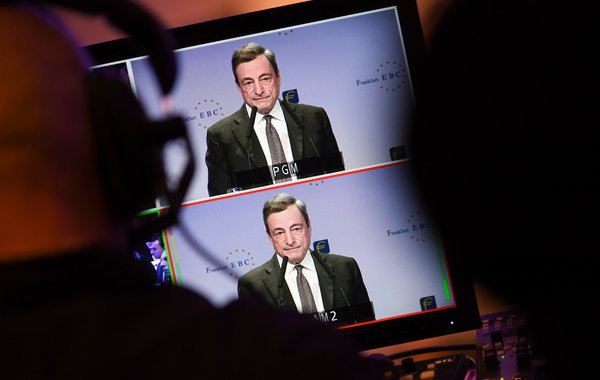Advertisement
Supported by

By Jack Ewing
Dec. 13, 2017
FRANKFURT — A lot is happening in the central banking world.
In Washington, the Federal Reserve has raised interest rates again to brake the sizzling United States economy. And the Bank of England is also in rate hiking mode.
Not so the European Central Bank. Expectations are low that Mario Draghi, the bank’s president, will make news on Thursday when he meets with reporters at the bank’s final meeting of 2017. The fireworks, though, will probably be coming in the New Year.
The central bank is not likely to make any major policy pronouncements in the short term, but the coming year may be a watershed. It could mark the end to the crisis measures that have been in place in the eurozone since 2008, and the beginning of a new era — with monetary policy returning to normal and the central bank beginning to gently push up interest rates.
Mr. Draghi’s news conference Thursday will most likely be dominated by questions about what 2018 holds for the eurozone economy and how the central bank would react.
Here are some of the things to watch for.
How much stimulus, and for how long?
The European Central Bank’s Governing Council set a course for 2018 when it announced plans in October to scale back the purchases of government and corporate bonds that it has been using to hold down interest rates and stimulate inflation. The bank said it would keep buying bonds at a reduced rate at least through September, and left open the door for continued purchases after that.
But investors and analysts have already begun speculating about whether the central bank will, at some point, rule out an extension of the debt purchases past September. That would set the stage for the central bank to start raising rates again for the first time in a decade.
Statements recently by members of the Governing Council have reinforced the speculation. Benoît Coeuré, a member of the European Central Bank’s executive board, said in November that he hoped the need for central bank stimulus will have run its course by September.
“There is a growing sense that the effectiveness of our monetary policy is now less reliant on our net asset purchases,” Mr. Coeuré said in an interview with the German newspaper Handelsblatt.
Reporters will grill Mr. Draghi about his opinion.
Will the economy stay on track?
The eurozone economy is humming. But it’s an open question what will happen when the central bank is no longer flooding the eurozone with cash.
The bank’s outlook on the state of the eurozone economy will be clearer Thursday, when its in-house economists issue their latest forecasts for growth and inflation. The estimates do not necessarily reflect the views of Mr. Draghi or all members of the Governing Council, but are closely watched for hints of where the bank thinks the economy is going.
If the bank’s economists raise their forecast for inflation, for example, that could push forward expectations of when the Governing Council will begin raising its benchmark interest rate, which is currently zero.
The new economic projections, “could well turn out to be the most interesting aspect of the E.C.B.’s December meeting,” economists at Oxford Economics said in a report to investors.
Out of sync?
The European Central Bank exercises strong influence over interest rates in the eurozone but it is also at the mercy of financial markets. They react to a host of forces — not the least of which is what the Fed is doing.
Now that the Fed is busy raising rates, there is a risk that the rising cost of credit could spill over to the eurozone, slowing down the economy before the European Central Bank is ready. The Bank of England raised its benchmark rate in November for the first time in a decade and, with British inflation on the rise, more hikes could be on the way. In effect, the European Central Bank is moving at a different speed than its two most important counterparts, even though their economies are closely intertwined.
Mr. Draghi will certainly be asked about the Fed’s action, and what the European Central Bank might do to keep rates low. At the same time, he is skilled at deflecting questions. But 2018 will be another matter.
“The E.C.B. has said and done everything it wanted to do this year,” Carsten Brzeski, an economist at ING Bank, said in a report to clients.
Follow Jack Ewing on Twitter: @JackEwingNYT.
The All-New DealBook
Please verify you’re not a robot by clicking the box.
Invalid email address. Please re-enter.
You must select a newsletter to subscribe to.
* Required field
Thank you for subscribing.
View all New York Times newsletters.
An error has occurred. Please try again later.
You are already subscribed to this email.
View all New York Times newsletters.
Advertisement
Article source: https://www.nytimes.com/2017/12/13/business/economy/ecb-draghi-rates.html?partner=rss&emc=rss
Speak Your Mind
You must be logged in to post a comment.